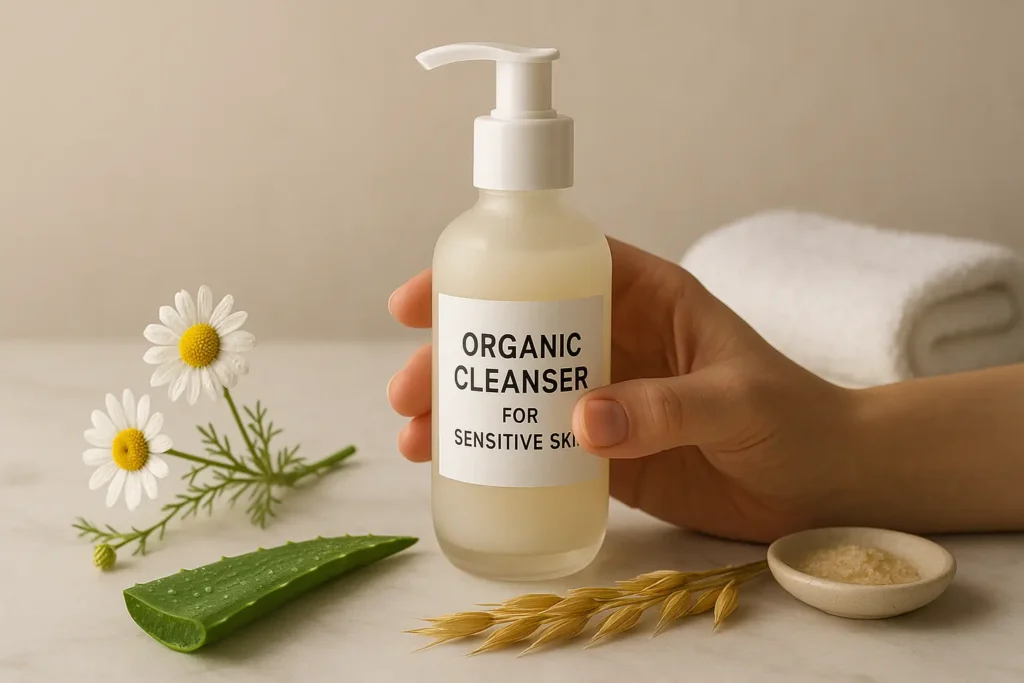Best Organic Cleansers for Sensitive Skin in 2025
Last week, a patient walked into my consultation room with her face red and blotchy, holding a gentle cleanser that had cost her $45. “It says hypoallergenic right on the bottle,” she said, tears welling up. I turned the bottle around and counted seven potential irritants in the first ten ingredients.
This happens more often than you’d think.
Here’s the thing—Dawnielle and Richard, in the Journal of Clinical and Aesthetic Dermatology, report that nearly 70% of people have sensitive skin at some point in their lives. If you’ve ever experienced that tight, stinging sensation after washing your face, or noticed redness creeping across your cheeks, you’re definitely not alone.
I’ve spent 18 years in medical practice, and honestly, the number one mistake I see people make isn’t about what they put ON their skin—it’s what they’re washing it with.
After completing specialized training in Cosmetic Formulation Science and working closely with hundreds of patients dealing with reactive skin, I’ve learned something crucial: your cleanser isn’t just removing dirt and makeup. It’s either protecting your skin barrier or slowly destroying it. There’s no middle ground.
That’s why I’m passionate about organic cleansers specifically designed for sensitive skin types. They eliminate the synthetic irritants, harsh sulfates, and hidden allergens that trigger inflammatory responses—while harnessing plant-based ingredients like chamomile, aloe vera, and oat extract to actually support your skin’s natural defense system.
In this guide, I’m sharing everything I’ve learned about choosing an organic cleanser that works WITH your sensitive skin, not against it. We’ll talk science, but I promise to keep it real.
Let’s get started.
What Makes a Cleanser Organic and Why It Matters for Sensitive Skin
So you’re standing in the skincare aisle (or scrolling through Amazon at midnight—no judgment), and every other bottle screams “organic” or “natural.” But what does that actually mean?
Understanding Organic Certification Standards
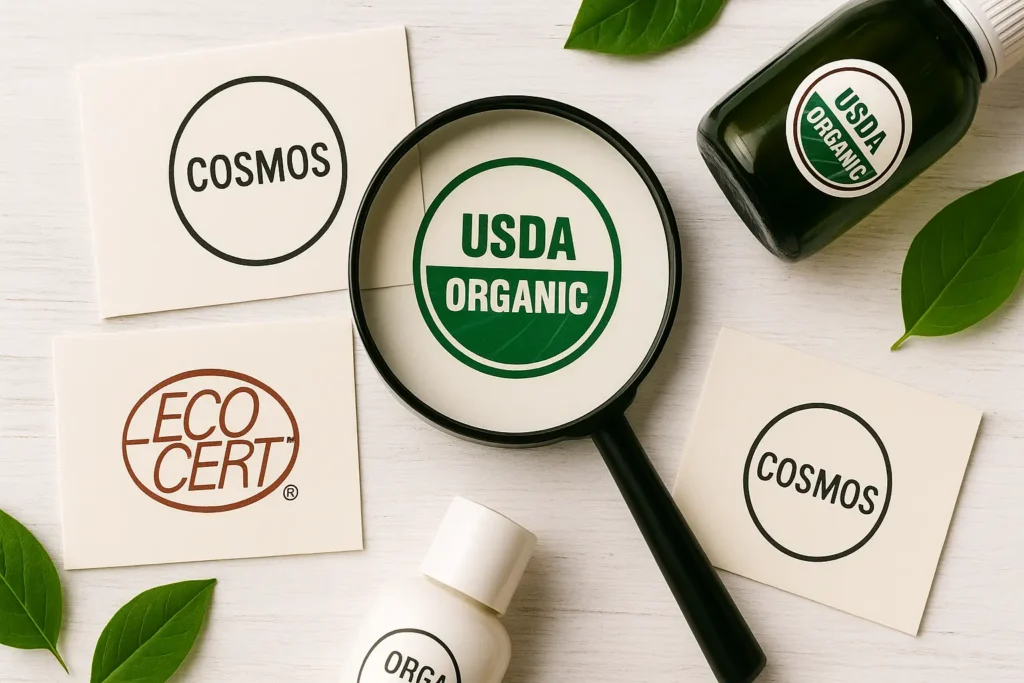
Real organic certification isn’t just marketing fluff. USDA Organic certification requires products to contain at least 95% organically produced ingredients—meaning no synthetic pesticides, no GMOs, and strict processing standards. COSMOS and Ecocert have similar requirements, though the percentages vary slightly.
Here’s where it gets interesting: certified organic skincare excludes ingredients grown with chemical fertilizers and pesticides that can leave residues on your skin. For sensitive skin types already dealing with compromised barriers, these microscopic irritants add insult to injury.
But—and this is important—organic doesn’t automatically mean hypoallergenic. I’ll get to that later.
The Science Behind Organic Ingredients and Skin Sensitivity
Your skin barrier is like a brick wall. The skin cells are bricks, and lipids (fats) are the mortar holding everything together. Conventional cleansers often contain harsh surfactants that literally dissolve this mortar, leaving gaps where irritants can penetrate.
Research published in the Journal of the American Academy of Dermatology shows that sulfate-based surfactants denature skin proteins and disrupt the skin barrier. Plant-based surfactants, on the other hand, cleanse more gently because they have larger molecular structures that don’t penetrate as deeply.
Think of it like this: synthetic surfactants are tiny needles that poke holes in your barrier. Plant-based alternatives are more like soft brushes that sweep away impurities without damaging the structure underneath.
Common Irritants Found in Conventional Cleansers
Let’s talk about the usual suspects lurking in your bathroom cabinet:
Sodium Lauryl Sulfate (SLS) and Sodium Laureth Sulfate (SLES) create that satisfying foam everyone loves. They’re also powerful degreasers—which explains why they’re used in garage floor cleaners. Your face deserves better.
Synthetic fragrances are the worst offenders. That innocent-looking word “parfum” or “fragrance” on an ingredient list can represent over 3,000 different chemical compounds, none of which manufacturers are required to disclose. The Environmental Working Group lists fragrance among the top five allergens in skincare products.
Parabens, phthalates, and formaldehyde-releasing preservatives extend shelf life but trigger contact dermatitis in sensitive individuals. I’ve seen patients develop reactions to products they’ve used for years because sensitivity can develop over time.
Key Ingredients to Look for in Organic Cleansers for Sensitive Skin
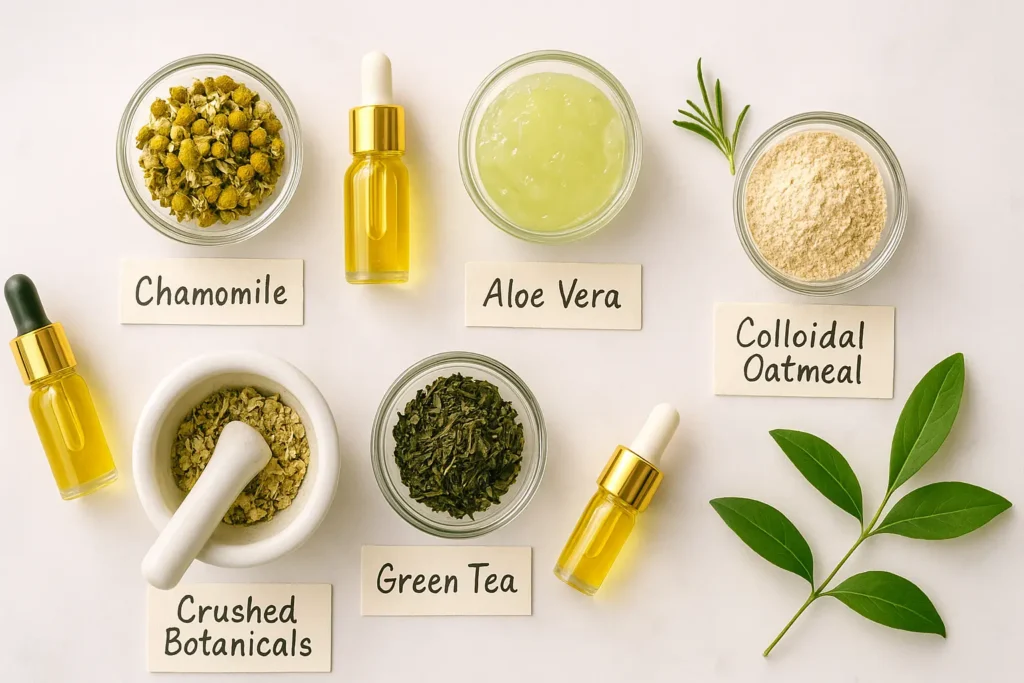
Now for the good stuff—what should you actually look for when shopping for an organic cleanser?
Soothing Botanical Extracts That Calm Inflammation
Chamomile extract isn’t just for bedtime tea. It contains bisabolol and chamazulene, anti-inflammatory compounds that reduce redness and calm irritated skin. Multiple studies confirm its effectiveness for sensitive skin conditions.
Calendula has been used for wound healing since medieval times, and modern research supports its use. This bright orange flower stimulates collagen production and repairs damaged skin barriers. I recommend it constantly for patients with eczema or rosacea.
Green tea extract provides powerful antioxidant protection. The polyphenols in green tea reduce inflammation and protect against UV damage. It’s particularly effective at reducing redness.
Colloidal oatmeal is actually FDA-approved as a skin protectant. The beta-glucans and avenanthramides in oats create a protective film on your skin while providing immediate itch relief. It’s one of the safest ingredients for extremely sensitive skin.
Gentle Plant-Based Cleansing Agents
Not all surfactants are created equal. Here’s what gentle cleansing looks like:
Decyl glucoside comes from coconut and corn. It’s so mild that it’s used in baby products, yet effective enough to remove makeup and sunscreen. It has a low irritation potential and biodegrades completely.
Coco-glucoside works similarly but creates a slightly creamier lather. It cleanses without stripping your natural oils—which is exactly what sensitive skin needs.
Saponins from plants like soapwort and yucca root are traditional cleansing agents that humans have used for thousands of years. They’re incredibly gentle but still effective at removing oil-based impurities.
Hydrating and Barrier-Supporting Ingredients
Here’s something most people don’t realize: a good cleanser doesn’t just remove dirt—it should actually support your skin barrier while cleansing.
Hyaluronic acid holds up to 1000 times its weight in water. When included in cleansers, it helps maintain moisture levels during cleansing rather than stripping everything away.
Glycerin is a humectant that draws moisture from the air into your skin. It’s one of the most effective moisturizing ingredients available, and it’s completely non-irritating.
Ceramides are lipid molecules naturally found in your skin barrier. Supplementing them through skincare helps repair and strengthen that protective wall we talked about earlier.
Aloe vera provides both hydration and anti-inflammatory benefits. The polysaccharides in aloe form a protective barrier on the skin while delivering soothing compounds.
Essential Oils vs. Fragrance-Free Options
This is where things get controversial.
Some essential oils—like lavender and tea tree—have legitimate antimicrobial and anti-inflammatory properties. But here’s the catch: they’re also among the most common allergens in natural skincare. The International Fragrance Association lists over 80 allergens commonly found in essential oils.
For truly sensitive skin, fragrance-free is almost always the safer choice. I know it’s tempting to want that spa-like aromatherapy experience, but your skin doesn’t care how the product smells. It cares about staying calm and balanced.
Top 7 Organic Cleansers for Sensitive Skin in 2025
After years of formulation research and patient testing, these are the organic cleansers I actually recommend—no sponsorships, no affiliate pressure—just genuine picks based on ingredient quality and real-world results.
Best Overall: Pai Skincare Camellia & Rose Gentle Hydrating Cleanser
This British brand doesn’t mess around. The formula centers on organic camellia and rosehip oils that cleanse while maintaining your skin’s pH balance at 5.5. It’s certified organic by the Soil Association, which has stricter standards than most certification bodies.
Key ingredients include omega-3 and omega-6 fatty acids that actually feed your skin barrier while removing impurities. The texture is a lightweight cream that emulsifies with water—no tight feeling afterward.
Best Budget-Friendly Option: Acure Seriously Soothing Cleansing Cream
Here’s proof that affordable can still mean high-quality. This cleanser costs under $10 and contains organic argan oil, pumpkin seed oil, and chamomile. It’s vegan, cruelty-free, and Leaping Bunny certified.
The formula lacks harsh sulfates and instead uses coconut-derived cleansing agents. It removes makeup surprisingly well for a cream cleanser. The only downside? It contains sunflower seed oil, which can be comedogenic for acne-prone sensitive skin.
Best for Extremely Sensitive and Reactive Skin: La Roche-Posay Toleriane Hydrating Gentle Cleanser
Okay, so technically this isn’t certified organic—but it deserves mention because it’s the cleanser I recommend most often for patients with severe sensitivity, rosacea, or eczema. The formula contains just 25 ingredients, and every single one serves a specific purpose.
It’s fragrance-free, soap-free, sulfate-free, and paraben-free. The star ingredient is La Roche-Posay Thermal Spring Water, which has a unique mineral content clinically shown to reduce inflammation.
Best Cream Cleanser for Dry Sensitive Skin: 100% Pure Nourishing Cleanser
This cleanser from 100% Pure combines organic coconut oil, avocado butter, and macadamia nut oil in a rich, nourishing base. It’s ideal for winter months, when sensitive skin can get extra dry and flaky.
The key here is the oil-to-water ratio. This formula contains enough oils to dissolve makeup and sunscreen while still rinsing clean without residue. It’s also naturally preserved with grapefruit seed extract and vitamin E—no synthetic preservatives needed.
Explore our full tutorial on Vitamin E to understand its skincare benefits.
Best Gel Cleanser for Combination Sensitive Skin: Juice Beauty Blemish Clearing Cleanser
Combination sensitive skin is tricky—you need something that controls oil in your T-zone without overdrying your cheeks. This organic gel cleanser uses willow bark (natural salicylic acid alternative) and organic aloe vera to balance cleansing with hydration.
It’s USDA Organic-certified and contains organic apple, lemon, and grape juices that provide gentle fruit-acid exfoliation. Use this one at night, not morning, because the active ingredients work best when your skin is repairing itself during sleep.
Best Oil Cleanser for Makeup Removal: One Love Organics Easy Does It Foaming Cleanser
This is technically an oil-to-foam cleanser, which gives you the best of both worlds. Start with the oil consistency to dissolve makeup and sunscreen, add water, and it emulsifies into a light foam that rinses completely clean.
The organic meadowfoam seed oil and rice bran oil are non-comedogenic and rich in antioxidants. It even removes waterproof mascara without tugging at the delicate eye area. This is my go-to recommendation for double cleansing without using two separate products.
Best Foaming Cleanser Without Harsh Sulfates: Beautycounter Countercontrol Cleansing Gel
If you can’t give up that foaming action, this cleanser creates a light lather using decyl glucoside instead of sulfates. It contains organic citrus oils for a fresh scent (skip if you’re sensitive to citrus), plus salicylic acid for gentle exfoliation.
Beautycounter’s safety standards ban over 2,800 potentially harmful ingredients, far more than what’s legally required. The formula is particularly good for sensitive, acne-prone skin.
How to Identify If Your Current Cleanser Is Irritating Your Sensitive Skin
Your skin talks to you constantly—you just need to learn its language.
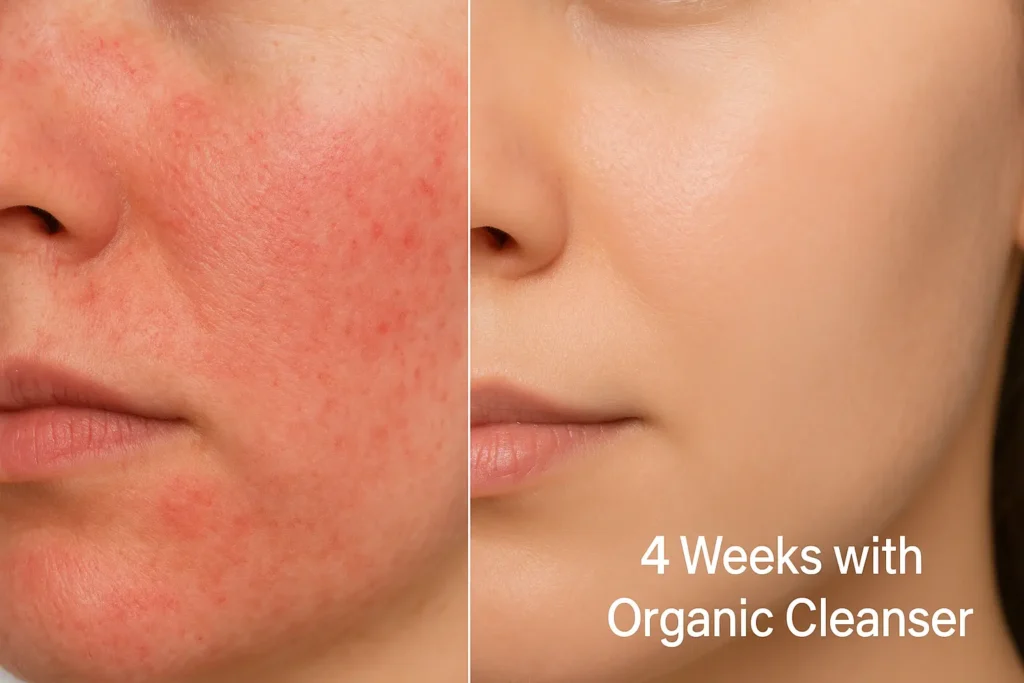
Warning Signs Your Cleanser Is Too Harsh
That “squeaky clean” feeling everyone brags about? It’s actually a red flag. Your skin should never feel tight after cleansing. Tightness indicates you’ve stripped away too much of your natural sebum, compromising your barrier function.
Immediate redness or flushing after washing means the cleanser is triggering an inflammatory response. This isn’t normal, despite what some people think. Healthy cleansing shouldn’t cause visible redness.
Increased breakouts after starting a new cleanser often signal irritation, not purging. True purging only happens with active ingredients like retinoids—not cleansers. If you’re breaking out, your skin barrier is likely compromised and allowing bacteria to penetrate more easily.
Persistent dryness despite religious moisturizer application suggests your cleanser is working against you. You shouldn’t need to layer on three different moisturizing products to recover from washing your face.
The 48-Hour Patch Test Method
Here’s how to test new cleansers properly—because jumping straight to your face is asking for trouble:
Apply a small amount of cleanser to the inside of your forearm or the back of your ear. Leave it on for 10 minutes (yes, I know cleansers are meant to be rinsed, but we’re testing for reactions). Rinse and observe for 48 hours.
If you see redness, bumps, or itching within those 48 hours, you’ve identified a reaction before it affects your entire face. It’s tedious, but it saves you from the misery of a full-face response that takes weeks to calm down.
Understanding Your Skin’s pH Balance
Your skin’s natural pH sits around 4.5-5.5—slightly acidic. This acid mantle protects you from bacteria, pollution, and moisture loss. Alkaline cleansers (pH above 7) disrupt this protective layer, leaving your skin vulnerable.
You can test your cleanser’s pH at home using simple pH strips from any pharmacy. Just mix a small amount with water and test the solution. If it’s above 6, it’s too alkaline for sensitive skin.
According to research by Dr. Zoe Draelos, published in the Journal of Cosmetic Dermatology, alkaline cleansers penetrate the skin and cause damage by disrupting the acid mantle. Her studies show that healthy skin regains its acid mantle within 15 to 30 minutes after cleansing, but repeated disruption with harsh cleansers can compromise this protective barrier.
The Proper Way to Cleanse Sensitive Skin: Dermatologist-Approved Techniques
You can have the best organic cleanser in the world and still damage your skin if you use it incorrectly.
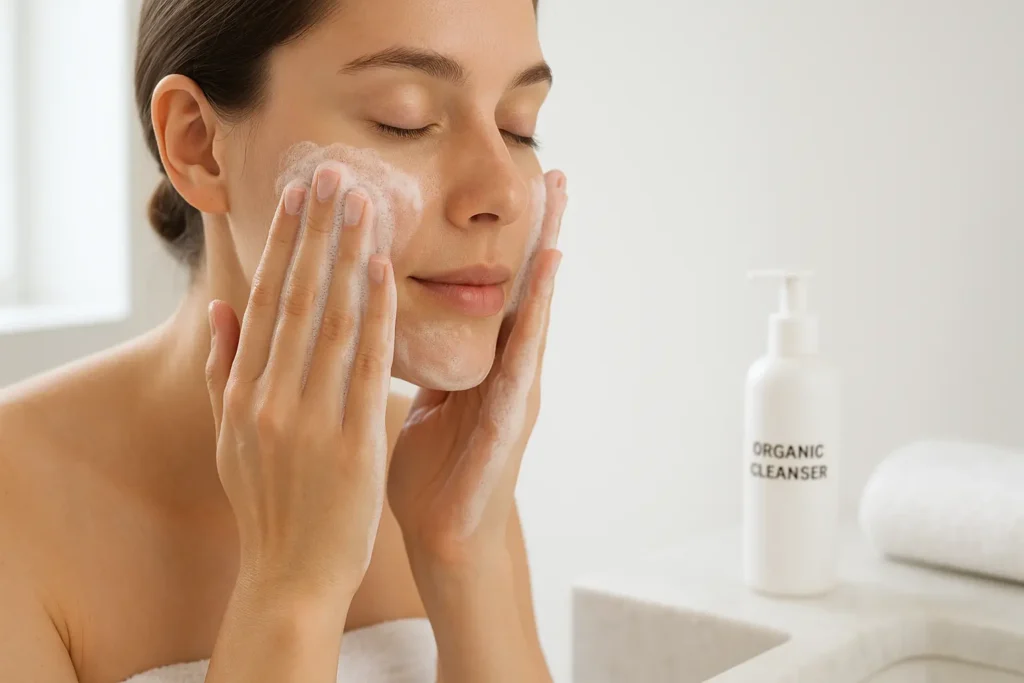
Water Temperature Matters More Than You Think
Hot water feels amazing, especially on cold mornings. It’s also a terrible idea for sensitive skin.
High temperatures dilate blood vessels, causing persistent redness in people prone to rosacea. Worse, hot water strips lipids from your skin barrier faster than harsh cleansers do. The National Eczema Association specifically warns against using hot water on sensitive, eczema-prone skin.
Lukewarm water—about the temperature of your body—is ideal. I know, it’s boring. But your skin will thank you with fewer red patches and less tightness.
A quick cold water splash at the end can help constrict capillaries and reduce inflammation. Just don’t overdo it—you’re not trying to shock your system, just gently cool things down.
The 60-Second Rule for Effective Cleansing
Most people either under-cleanse (a 10-second splash) or over-cleanse (an aggressive 2-minute scrubbing session). Neither works well.
Research shows that 60 seconds of gentle cleansing effectively removes dirt, oil, and impurities without damaging the skin barrier. Here’s the technique:
Wet your face with lukewarm water. Apply a dime-sized amount of cleanser (you need less than you think). Use gentle, circular motions with your fingertips—never scrub. Focus on areas where you have more oil production or wear makeup. Rinse thoroughly for at least 20 seconds.
That’s it. No fancy tools required, though I’ll allow a soft muslin cloth if you prefer that texture.
Double Cleansing: When It Helps and When It Hurts
The K-beauty double cleanse method has taken over, but it’s not right for everyone.
When double cleansing helps: You’ve worn heavy makeup or water-resistant sunscreen all day. You live in a highly polluted city. You have oily or combination sensitive skin.
When it’s overkill: You didn’t wear makeup or sunscreen that day. You have extremely dry or reactive skin. You’re cleansing in the morning (more on that next).
If you’re double cleansing, always start with an oil-based cleanser or micellar water to break down oil-based products, then follow with a gentle water-based cleanser. Never use two harsh cleansers back-to-back-that’s a recipe for barrier damage.
Pat Dry, Never Rub: Post-Cleansing Best Practices
This seems so basic, but I can’t tell you how many patients rub their faces vigorously with rough towels and wonder why their skin stays irritated.
Friction causes micro-tears in sensitive skin. These tiny injuries compound over time, leading to chronic inflammation and increased sensitivity.
Pat your face gently with a soft, clean towel. Even better, use organic cotton or bamboo towels that don’t have the rough texture of regular terry cloth.
Here’s the most important part: apply your moisturizer within 60 seconds of cleansing. Damp skin absorbs moisture better, and this timing takes advantage of the hydration from water still on your skin’s surface.
Ingredients to Avoid in Cleansers When You Have Sensitive Skin
Let’s talk about the ingredients that have no business touching your sensitive skin.
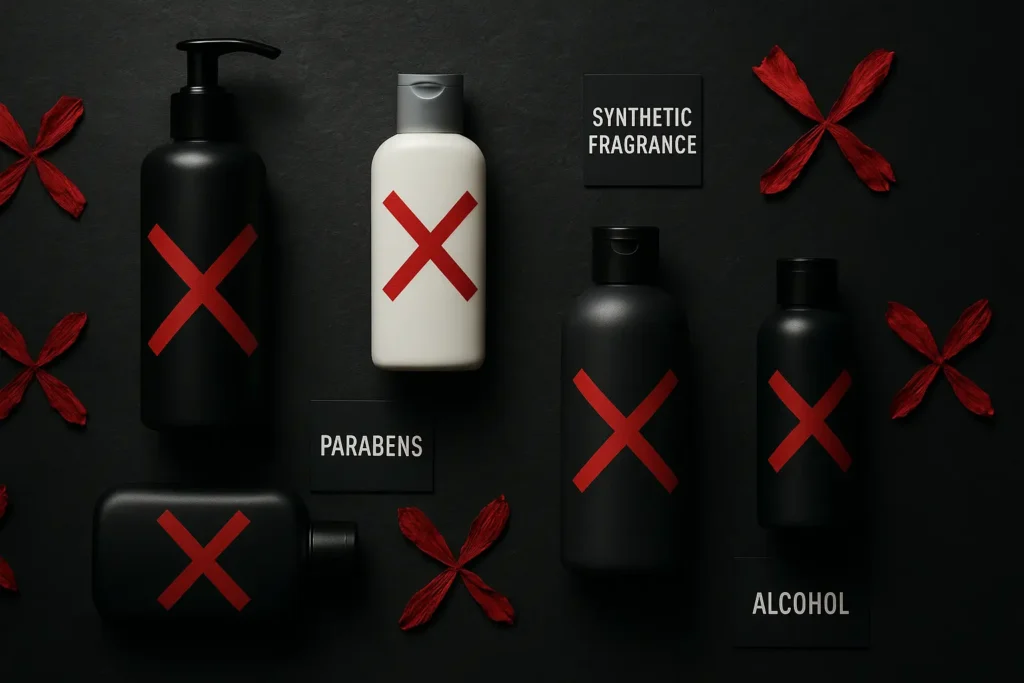
Harsh Surfactants That Strip Your Skin Barrier
Sodium Lauryl Sulfate (SLS) is a protein denaturant—meaning it literally breaks down the proteins that hold your skin barrier together. It’s cheap, effective, and brutal on sensitive skin. According to research published in Contact Dermatitis, SLS is among the most common causes of irritant contact dermatitis.
Ammonium Lauryl Sulfate isn’t much better. Despite marketing claims that it’s “gentler” than SLS, it still disrupts the skin barrier and can irritate sensitive individuals.
Safer alternatives include decyl glucoside, coco-glucoside, and sodium cocoyl isethionate. These plant-derived surfactants cleanse effectively without aggressive barrier disruption.
Synthetic Fragrances and Hidden Allergens
I mentioned this earlier, but it bears repeating because it’s such a massive problem: the word “fragrance” or “parfum” on an ingredient list is a black box. It can contain literally hundreds of undisclosed chemicals.
The American Academy of Dermatology identifies fragrance as one of the leading causes of cosmetic contact dermatitis. For sensitive skin, this is non-negotiable—if it lists “fragrance” or “parfum,” put it back on the shelf.
Natural fragrances can be problematic, too. Essential oils like lavender, citrus, and ylang-ylang are among the most common natural allergens. If your cleanser needs to smell like something, make sure it’s from whole plant extracts rather than isolated fragrance compounds.
Alcohol and Astringent Ingredients
Here’s where confusion happens: not all alcohols are bad.
Denatured alcohol (often listed as alcohol denat., SD alcohol, or isopropyl alcohol) is extremely drying and irritating. It’s used to help products dry quickly and feel lightweight, but it decimates sensitive skin by destroying lipids in the skin barrier.
Fatty alcohols (cetyl alcohol, stearyl alcohol, cetearyl alcohol) are completely different. These are moisturizing ingredients derived from coconut or palm oil. They’re safe for sensitive skin and actually beneficial.
Witch hazel deserves special mention. In its pure, alcohol-free form, it has anti-inflammatory properties. However, most drugstore witch hazel products contain high concentrations of drying alcohol. Check the ingredient list carefully.
Menthol, peppermint, and eucalyptus create that cooling, tingling sensation people associate with “clean” skin. That sensation is actually irritation. These ingredients activate TRPM8 receptors that signal cooling but also trigger inflammatory responses in sensitive skin.
Physical Exfoliants and Scrub Particles
Walnut shells, apricot kernels, and microbeads have no place in sensitive skin cleansers—or any cleansers, really.
These particles create microscopic tears in your skin. Research using electron microscopy has shown that physical scrubs cause irregular, jagged tears in the skin surface that take days to heal. For sensitive skin already compromised by a weakened barrier function, this is disastrous.
If you need exfoliation (and honestly, not everyone does), gentle chemical exfoliants like lactic acid or polyhydroxy acids (PHAs) are much safer. They dissolve dead skin cells without mechanical abrasion.
For a deeper dive into DIY exfoliating options, check out this guide.
Organic Cleanser Myths Debunked: What Science Really Says
Time to bust some persistent myths that keep people from making good skincare decisions.
Myth: Organic Always Means Hypoallergenic
This is the biggest misconception in natural skincare.
Organic certification means the ingredients were grown without synthetic pesticides—it says nothing about allergenicity. In fact, some of the most common skincare allergens are completely natural: tea tree oil, lavender, chamomile (yes, even chamomile can cause reactions in some people), and propolis.
A study in the British Journal of Dermatology found that natural skincare products caused allergic contact dermatitis at rates similar to conventional products—just with different allergens. The lesson? Always patch test, regardless of certification status.
Myth: Foaming Cleansers Are More Effective
Foam is theater. It’s a psychological cue that makes you feel like the product is working harder.
The cleansing power comes from surfactants, not bubbles. Cream and oil cleansers can be just as effective—sometimes more so—without creating any foam. Studies show that both foaming and non-foaming cleansers can be equally effective, with women reporting statistically significant improvements in skin cleanliness, radiance, and satisfaction with both types.
For sensitive skin, less foam often means gentler cleansing, because the most aggressive surfactants create the most luxurious lather.
Myth: You Need Different Cleansers for Morning and Night
The skincare industry loves selling you multiple versions of essentially the same product.
For truly sensitive skin, one gentle cleanser is usually sufficient for both morning and evening. The exception is if you wear heavy makeup or water-resistant sunscreen—then a dedicated first-step cleanser for evening might be helpful.
Morning cleansing can actually be water-only for many people with sensitive or dry skin. While you sleep, your skin isn’t exposed to makeup, sunscreen, or environmental pollution. You’re just removing natural oils your skin produced overnight—and honestly, those oils are beneficial. Stripping them away first thing in the morning can make your skin produce even more oil to compensate.
Myth: Expensive Organic Cleansers Work Better
Price correlates with marketing budget, packaging, and brand positioning—not necessarily with effectiveness.
I’ve seen $10 cleansers with ingredient lists that blow $80 luxury brands out of the water. The active ingredients in skincare are commodity chemicals. A manufacturer pays roughly the same amount for high-quality hyaluronic acid or chamomile extract regardless of whether it ends up in a budget brand or a luxury product.
What you’re paying for with expensive brands: elegant packaging, celebrity endorsements, department store placement, glossy magazine ads, and sometimes—but not always—higher concentrations of active ingredients.
Check the ingredient list. If an affordable organic cleanser has the same actives in similar concentrations as a luxury option, save your money.
Building a Complete Organic Skincare Routine Around Your Cleanser
Your cleanser is just the foundation—here’s how to build the rest of your routine.
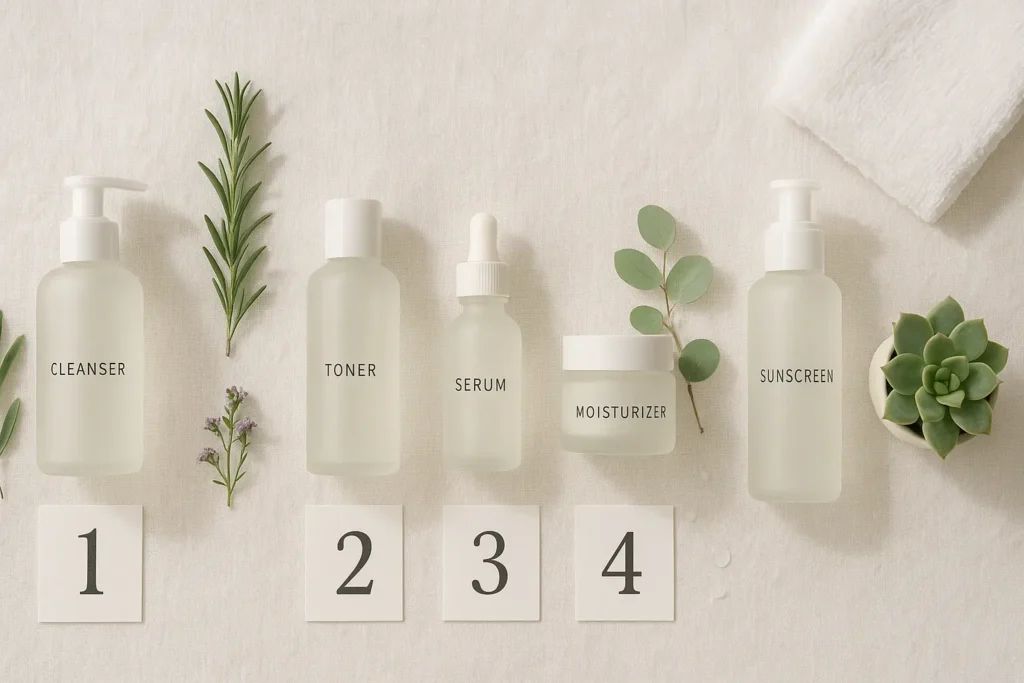
The Correct Order: Cleanse, Tone, Treat, Moisturize
This order isn’t arbitrary—it’s based on how skin absorption works.
Cleansing comes first, obviously, to remove barriers that prevent other products from penetrating. Clean skin absorbs subsequent products up to 30% more effectively than uncleaned skin.
Toning (optional, honestly) can help rebalance pH after cleansing and prepare skin for treatments. But if you’re using a pH-balanced organic cleanser, you might not need this step at all.
Treating means serums, essences, or active ingredients applied to address specific concerns. These go on clean, slightly damp skin for maximum absorption.
Moisturizing seals everything in and provides occlusion to prevent water loss. This is non-negotiable for sensitive skin—never skip your moisturizer after cleansing.
Choosing Compatible Organic Toners and Serums
Not every toner plays nicely with sensitive skin. Avoid anything with high alcohol content or astringent ingredients.
Good options for sensitive skin include hydrating toners with hyaluronic acid, rose water (if you’re not sensitive to roses), or thermal spring water. These add an extra layer of hydration without irritation.
For serums, please keep it simple. A basic hyaluronic acid serum or niacinamide serum (at 5% concentration or lower for sensitive skin) can address multiple concerns without overwhelming your skin.
The key is to introduce new products one at a time, waiting at least 2 weeks before adding another. This way, if something causes a reaction, you’ll know exactly what did it.
Moisturizing Immediately After Cleansing
I mentioned the 60-second window earlier—it’s worth emphasizing again.
Your skin loses water rapidly after cleansing, especially if you’re in a dry environment. Applying moisturizer while your skin is still slightly damp helps lock in that hydration. The water on your skin’s surface is trapped beneath the moisturizer, increasing hydration.
For sensitive skin, look for organic moisturizers with minimal ingredients. Ceramides, fatty acids, and cholesterol (yes, good cholesterol exists in skincare) help repair barrier function. Avoid heavy essential oils if you’re very sensitive.
Sun Protection: The Non-Negotiable Final Step
You can have the perfect organic cleansing routine—whether you’re using gentle cleansers for sensitive skin or any other formula—but without sun protection, you’re undermining all your efforts.
For sensitive skin, mineral sunscreens with zinc oxide or titanium dioxide are usually best tolerated. These sit on top of your skin and physically block UV rays, rather than being absorbed like chemical sunscreens.
Organic mineral sunscreens are available—brands like Badger and All Good offer USDA Organic-certified products with minimal ingredients. Yes, they can leave a slight white cast. That’s the trade-off for avoiding chemical filters that often irritate sensitive skin.
Reapply every two hours of sun exposure. I know it’s annoying, but UV damage causes 80% of visible skin aging and significantly worsens sensitivity over time.
Expert Tips from 18 Years of Skincare Experience
These are the insights I’ve gained from working with thousands of patients and studying cosmetic formulation science.
When to Simplify Your Routine
More products don’t equal better results—especially for sensitive skin.
If you’re using more than five products (cleanser, moisturizer, treatment, sunscreen, plus one other step), you might be overwhelming your skin. Every additional product is another opportunity for irritation or a bad ingredient interaction.
Signs you need to simplify: persistent irritation despite using “gentle” products, confusion about what’s helping vs. hurting, spending more than 15 minutes twice daily on skincare, or overwhelming anxiety about your routine.
My minimalist sensitive skin recommendation: organic cleanser, simple moisturizer with ceramides, mineral sunscreen. That’s it. Add treatments only if you have specific concerns and your skin barrier is healthy enough to handle them.
Seasonal Adjustments for Your Organic Cleanser
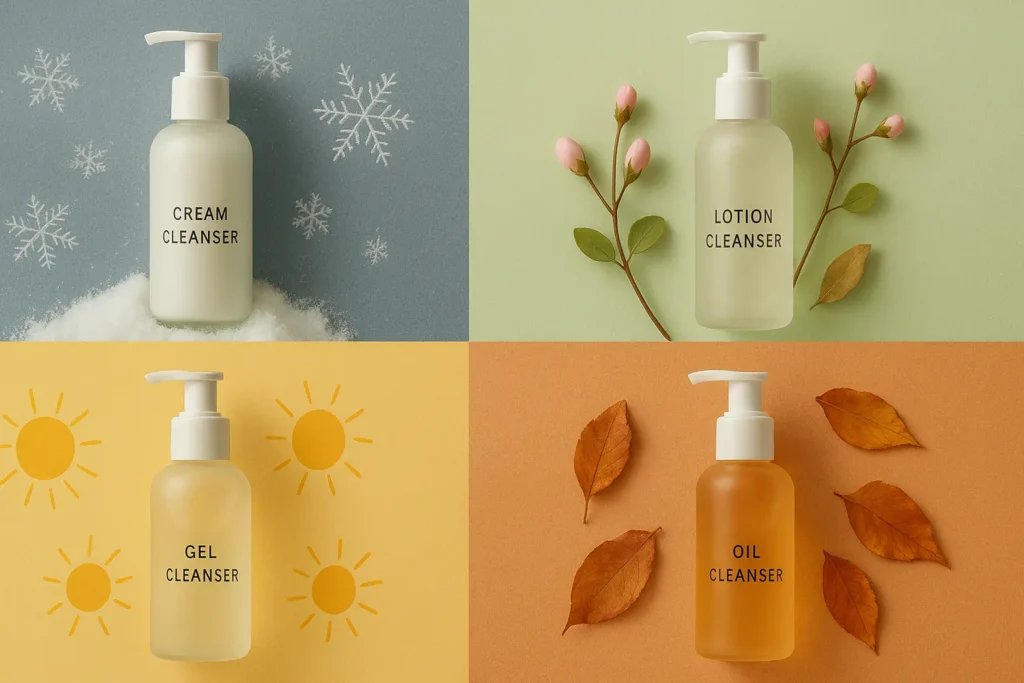
Your skin’s needs change with the weather—your cleanser should too.
Winter: Switch to cream or oil cleansers that add moisture rather than strip it. Indoor heating and cold winds destroy hydration levels. I personally switch to a cleansing oil every November and don’t look back until spring.
Summer: Gel cleansers work well in humidity because they remove excess oil without over-drying. You might need to cleanse twice daily in summer if you’re very oily, but keep the morning cleanse gentler than the evening.
Transition seasons (spring and fall) can be tricky. Your skin might not know what it wants. This is when having two different cleansers—a lighter gel and a richer cream—lets you adjust based on daily conditions.
Travel-Friendly Organic Cleansing Solutions
Travel disrupts your routine and exposes your skin to new stressors: airplane air, different water quality, hotel air conditioning, and climate changes.
TSA-approved sizes (3.4oz or 100ml) of your favorite organic cleanser should always be in your carry-on. If you’re traveling internationally where liquids are restricted, solid cleansing bars are lifesavers. Brands like Ethique and HiBar make effective, long-lasting cleansers that last for dozens of uses.
Hard water warning: Some destinations have very hard water (high mineral content) that can interact poorly with organic cleansers, leaving a film on your skin. If you notice this, bring micellar water as a no-rinse cleansing alternative.
Consulting a Dermatologist: When DIY Isn’t Enough
I’m a big believer in empowered self-care, but some situations need professional intervention.
See a dermatologist if your sensitivity persists despite using appropriate products for 6-8 weeks, if you develop sudden severe reactions, if you have persistent redness that could indicate rosacea, or if you’re experiencing pain or burning rather than just mild discomfort.
Conditions such as rosacea, perioral dermatitis, and seborrheic dermatitis can mimic simple sensitivity but require specific treatment. A board-certified dermatologist can properly diagnose these conditions and recommend medical-grade therapies that work alongside your organic cleanser.
Finding a derm who respects your preference for organic skincare might take some searching, but they exist. Don’t compromise your health values—ask potential dermatologists about their approach to natural and organic skincare during your first consultation.
Conclusion: Organic Cleansers for Sensitive Skin
After 18 years in medical practice, I’ve seen the transformation that happens when people switch to the right organic cleanser. The redness fades, the tightness disappears, and constant irritation becomes a memory.
Your skin has an incredible capacity to heal when you stop assaulting it with sulfates and synthetic fragrances. Start simple—choose one fragrance-free, sulfate-free organic cleanser from my recommendations. Patch test it. Give it four to six weeks before judging results.
Be patient. You didn’t damage your skin barrier overnight, and you won’t repair it overnight either. But give your skin the right tools, and it will reward you with health, comfort, and natural radiance.
Have questions about choosing your perfect organic cleanser? Drop them in the comments—I read and respond to every single one. And if you found this guide helpful, share it with someone who’s still struggling with sensitive skin. I’m sure they’ll thank you for that.
FAQ: Best Organic Cleansers for Sensitive Skin
What Kind Of Cleanser Is Best For Sensitive Skin?
The best cleanser for sensitive skin is a fragrance-free, sulfate-free formula with a pH of 4.5-5.5. Cream or gel cleansers containing soothing ingredients like colloidal oatmeal, chamomile, or ceramides work best. Avoid harsh surfactants like SLS, synthetic fragrances, and physical exfoliants, as they can disrupt your skin barrier.
What Is The Best Organic Cleanser For Sensitive Skin?
The best organic cleanser for sensitive skin is one that’s fragrance- and sulfate-free and contains soothing ingredients like chamomile, aloe vera, or colloidal oatmeal. Look for USDA Organic or COSMOS certification, minimal ingredient lists, and pH-balanced formulas between 4.5 and 5.5 that won’t disrupt your skin barrier.
What Is The Best Face Cleanser For Sensitive Skin?
La Roche-Posay Toleriane Hydrating Gentle Cleanser is dermatologist-recommended for extremely sensitive skin and contains only 25 essential ingredients. For certified organic options, Pai Skincare Camellia & Rose Cleanser offers superior gentleness. Both are fragrance-free, sulfate-free, and pH-balanced to protect your skin’s natural barrier without causing irritation or tightness.
Are Organic Cleansers Better For Sensitive Skin?
Yes, organic cleansers typically benefit sensitive skin because they exclude synthetic irritants, harsh sulfates, artificial fragrances, and pesticide residues. They use plant-based ingredients that cleanse gently while supporting the skin barrier. However, some natural ingredients can still cause reactions, so patch testing remains essential.
Is It Better To Use Organic Or Natural Cleansers?
Organic cleansers are certified to contain at least 95% organically grown ingredients, free of synthetic pesticides and GMOs. “Natural” is an unregulated marketing term with no legal definition. For sensitive skin, look for certified organic products with recognized certifications like USDA Organic, COSMOS, or Ecocert.
Which Brand Is Best For Sensitive Skin?
Top brands for sensitive skin include La Roche-Posay, CeraVe, Vanicream, and Cetaphil, all with dermatologist-tested formulas. For organic options, choose Pai Skincare, Acure, 100% Pure, or Beautycounter. These brands prioritize minimal ingredients, avoid common irritants, and undergo extensive safety testing specifically for reactive, sensitive skin types.
Which Cleanser Do Dermatologists Recommend?
Dermatologists most commonly recommend Cetaphil Gentle Skin Cleanser, CeraVe Hydrating Cleanser, La Roche-Posay Toleriane, and Vanicream Gentle Facial Cleanser. These brands are fragrance-free, non-comedogenic, and clinically tested for sensitive skin. They contain barrier-supporting ingredients like ceramides and glycerin while avoiding harsh sulfates and known irritants that trigger inflammation.
Can I Use An Organic Cleanser If I Have Rosacea?
Yes, many organic cleansers work well for rosacea-prone skin. Choose fragrance-free formulas with anti-inflammatory ingredients like chamomile, green tea, or colloidal oatmeal. Avoid essential oils, alcohol, menthol, and physical exfoliants. Always consult your dermatologist for personalized recommendations based on your rosacea severity.
What Ingredients Should I Avoid In Cleansers For Sensitive Skin?
Avoid sodium lauryl sulfate (SLS), synthetic fragrances, denatured alcohol, parabens, phthalates, artificial dyes, harsh physical exfoliants, menthol, eucalyptus, and strong essential oils. These ingredients commonly trigger inflammation, allergic reactions, and barrier disruption in sensitive skin types.
Do Organic Cleansers Remove Makeup Effectively?
Yes, organic oil cleansers and micellar waters effectively remove makeup without harsh chemicals. For waterproof makeup, use the double-cleansing method: start with an organic oil cleanser, then follow with a gentle gel or cream cleanser. This removes all traces without irritating sensitive skin.
Can Organic Cleansers Cause Breakouts?
Yes, some organic ingredients may cause breakouts if they’re comedogenic (pore-clogging) or if you’re sensitive to specific botanical extracts. Coconut oil, olive oil, and some heavy cream formulas can trigger acne in sensitive, combination, or oily skin types. Choose non-comedogenic, lightweight organic cleansers instead.
Disclaimer: GlowGuideHub participates in the Amazon Services LLC Associates Program, an affiliate advertising program designed to provide a means for sites to earn advertising fees by advertising and linking to Amazon.com. As an Amazon Associate, I earn from qualifying purchases. If you click on an Amazon link on my site and make a purchase, I may earn a commission at no additional cost.

